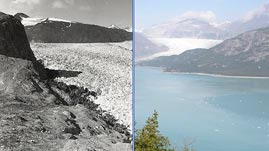Although ice is generally thought of as rigid, glaciers are not stationary masses. In fact, in order to be considered a glacier, an ice mass must be of sufficient size and thickness to cause motion. Its sheer weight becomes so great that gravity forces a glacier to spread outward and downslope.
A glacier moves according to its mass balance—the difference between how much snow and ice a glacier gains each year relative to how much it loses. When the amount of snow and ice accumulated on a glacier through precipitation or wind deposits exceeds the amount lost due to melting, wind erosion, or breaking off into the sea, it is said to have a positive mass balance year. During extended warm periods, when the snow and ice lost over a year exceeds what is gained, the mass balance is negative.
While a series of positive mass balance years may prompt the glacier to advance downslope, a series of negative years may cause the glacier to recede. For most glaciers, advancing and receding are noticeable only over a long time. However, when glaciers recede rapidly, movement may be evident over just a few months or years.
Glacial movement plays an important role in shaping landscapes. In mountainous regions, glacial erosion widens and deepens a V-shaped river valley that guides a glacier's flow. When the ice thaws, a U-shaped valley is revealed. Stray boulders that have been deposited far from their source, known as glacial erratics, often litter this transformed landscape. Deep grooves, or striations, in exposed bedrock are other telltale signs of glacial movement.
In this collection of images, you can see evidence of what happens to the landscape, especially when valley glaciers recede. For example, in the Carroll Glacier pairing, the more recent image clearly depicts the U-shaped valley, the terminal moraine (debris pile) that marks the limit of the glacier's advance, and vegetation where previously only rocks were present. Also, much of the water seen covering the river valley has receded along with the glacier.
Since 1900, most glaciers around the world have retreated. The retreat is probably linked to global warming, whose effect on ice could have potentially serious consequences for humans. Accelerated melting of valley glaciers could produce catastrophic flooding followed by long-term drought, which would affect hundreds of millions of people who rely on stable glaciers to provide water for agriculture and their drinking supply.




 Teachers' Domain is proud to be a Pathways portal to the National Science Digital Library.
Teachers' Domain is proud to be a Pathways portal to the National Science Digital Library.